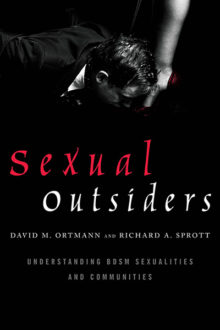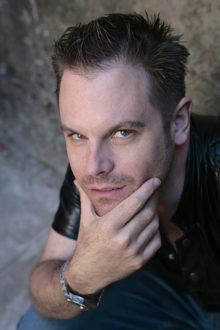 Sexual Outsiders: Understanding BDSM Sexualities and Communities
Sexual Outsiders: Understanding BDSM Sexualities and Communities
by David M. Ortmann and Richard A. Sprott
Published by Rowman & Littlefield
Published February 9, 2015
Psychology
173 pgs.
Find on Amazon.com • WorldCat
Reviewed by C. Todd White
July 14, 2015
While the subject matter of BDSM sexualities may not seem like the material from which literary classics are made, David Ortmann and Richard Sprott’s brave new book is indeed remarkable, an exceptional work in many ways.
San Francisco-based psychologist Richard Sprott was trained as a social linguist interested in child language development who now studies sexual development in adults. David Ortmann is a practicing psychotherapist in New York who has years of experience in the subject. The two writers compliment each other so entirely that the tone of Sexual Outsiders remains uniform and conversational from start to end, and the overlap between linguistics and psychology gives the book at once a depth and clarity that neither writer could have accomplished on his own—which is as any fruitful act of collaboration should be.
Through extensive engagement with the subject(s), the authors posit that there is nothing inherently “good” or “bad”with BDSM practices. They call it a “neutral concept” that can vary drastically in range from being intensely gratifying to becoming self destructive or “toxic.”
The worst thing, the writers agree, is for a practitioner, or even one so interested, to remain alone and isolated, cloaked in a destructive field of shame. But shame is but one of the salient themes of this book. The second is community. To keep a kink-based sexual relationship healthy, Sprott and Ortmann advocate for active community engagement, tying in to the “thriving and healthy” subculture involving BDSM that, as they demonstrate, exists in the United States and abroad.

Of course, the “coming out” approach to BDSM that Sprott and Ortmann advocate will resonate with the LGBT community. As many can testify, “coming out” is always a risky endeavor—terrifying even. But, as the authors state, “those risks may be the price of creativity, eros, and loving life in an exciting, sensational, and even meaningful way.”
Sexual Outsiders can be read as an act of consciousness raising, an effort to clear a path by challenging the “negative stereotypes, misinformation, and ignorance around BDSM sexuality and thereby increase the health and well-being of our entire society.” And this it does exceedingly well.
The authors argue that a healthy attitude toward sexuality is essential not only for sexual practitioners but also for society itself. As a cultural anthropologist this is where I felt the book took a particularly interesting turn. Sprott and Ortmann believe that in connecting with some sense of history, community, and legacy, sexual pariahs who have felt shame or have been estranged from their families can learn from—and be inspired by—the successes of other civil rights movements. Coming out, they say, can be like coming home, finding a nurturing and supportive community in which to grow:
Healthy BDSM behavior is much more likely when a person is connected and integrated into the organized BDSM community. It is here that a person can learn how to manage consent, learn technical skills, and figure out how to address the internalized shame and anger that arises from having to deal with stigma and the threat of rejection.
The authors’ approach to gender activism comes with some noteworthy caveats. While the authors celebrate the successes the movement for women’s liberation, they simultaneously critics the movement in general for it’s emphasis of, and even expectation for, sexual equality and gender parity between partners:
There are men and women who find it more natural to relate in ways that are complementary rather than egalitarian, emphasizing differences in roles to create a polarity that allows for the exchange of power.
And power, they say, can be one heck of an aphrodisiac.
The ability to play with power, manipulate power, and exchange power opens doors to more colorful and exciting parts of our sexual landscape.
The real “spice” of the book, unsurprisingly, comes from Ortmann’s descriptions of his clients and their personal situations. I would not describe this book as titillating, though—we are a far cry from David Reuben or Laud Humphries here. On the other hand, there are few passages that might offend the squeamish and uninitiated.
You don’t have to be a sexual outsider to enjoy this book. What is required is a nonjudgmental curiosity about human sexuality in all its myriad forms. If you fit this criteria, then this is an excellent study that I highly recommend.
A version of this review was first published by Out In Jersey magazine.
©2015, 2017 by C. Todd White. All rights reserved.

